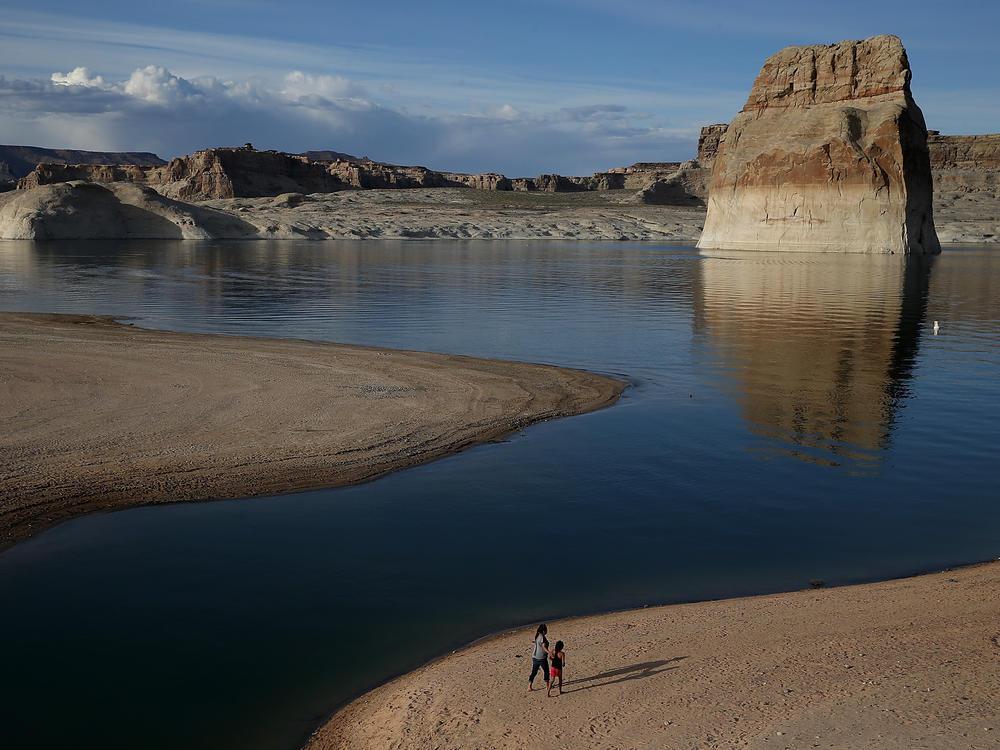Section Branding
Header Content
The Colorado River rarely reaches the sea. Here's why
Primary Content
For most of its 6 million-year existence, the Colorado River ran from the Continental Divide, high in the Rocky Mountains, downward and west, through forest and red rock, to a lush delta at the northernmost tip of the Gulf of California. Its winding descent carved, among other wonders, what people now call the Grand Canyon.
Today, the Colorado is so siphoned and stalled by canals and dams that only a trickle of its water ever reaches the sea. Its terminus is now a salt flat.
A new study, published in the journal Communications Earth & Environment, looks at where all of that water is going.
Nineteen percent of the Colorado River is consumed by the natural environment — wetlands and riparian areas, the study found. The rest is taken by people, primarily to grow feed for livestock.
Water for cattle-feed crops — alfalfa and other grasses — accounted for roughly one-third (32%) of the Colorado River's annual flow, the study found. Agriculture accounts for about three times the usage of cities.
"We consume every single drop," said Brian Richter, a senior freshwater fellow for the World Wildlife Fund, president of Sustainable Waters and the study's lead author. "And yet, there's never been a complete and detailed accounting for where all that water is going. So we felt it was about time to do that."
The study, which builds on prior research and offers the most detailed analysis of how the water is used to date, looked at two decades of data starting in 2000, a time frame that coincides with the rapid expansion of cities and what scientists have called the worst megadrought in the region in at least 1,200 years.
A study published last year found that during the megadrought, human-caused global warming decreased the Colorado River's natural flow by roughly the amount of water that can be stored in Lake Mead — the nation's largest reservoir.
It's long been known that the Colorado River — and the 40 million people who rely on it — are facing a crisis. Water is overallocated. More is promised to cities and irrigators than typically exists. Climate change is shrinking the available pool.
Water users in seven states, Native American tribes, and the federal government are in sticky negotiations over how to divvy up the diminishing resource in the future. The current guidelines for how the river is allocated expire in 2026 and the two factions of states, divided by the Upper Basin (Colorado, New Mexico, Utah and Wyoming) and Lower Basin (California, Arizona and Nevada), still can't agree on how to reduce demand.
"Right now there's very intense negotiations taking place over how the river's water will be shared in the future," Richter said. "We wanted those negotiators to have these data in front of them so those debates could be well-informed."
Livestock feed uses most of the diminishing water
Irrigation — water for 5 million acres of cropland — uses more than half of the Colorado River's annual flow, the paper found. The vast majority of that went to alfalfa and other grasses to support the country's beef and dairy industries.
"They're growing the things that we want and are willing to pay for," Richter said.
It's estimated that livestock farming produces between 11.1 % and 19.6% of the world's climate-warming emissions.
In the less-populated Upper Basin, irrigation accounted for nearly 90% of the water consumption.
"It is a fact that agriculture uses a lot of water," said Sharon Megdal, director of the Water Resources Research Center at the University of Arizona. "And what that really means is that there will be the most opportunity for reductions in water use through, whether you call it precision agriculture, climate-smart agriculture, or more efficient water use.
"I think our ability to adapt is being tested and will continue to be," said Megdal, who wasn't involved in the study. "But I have some confidence that we will be able to."
The Biden administration has spent more than $670 million on two dozen water conservation projects in California and Arizona. Last year, Lower Basin states (California, Arizona and Nevada) agreed to cut back their use in the short term. Many farmers are taking steps to prepare and adapt.
"We all need to become far more water literate because there are some hard choices ahead," said Felicia Marcus, a fellow at Stanford University's Water in the West Program and former chair of the California State Water Resources Control Board.

